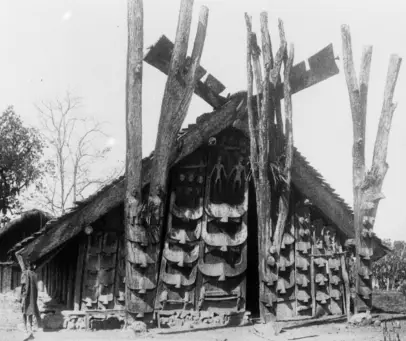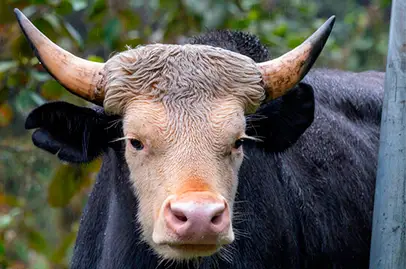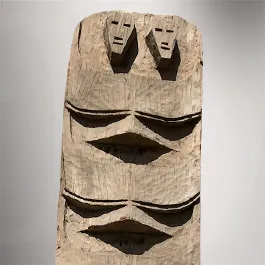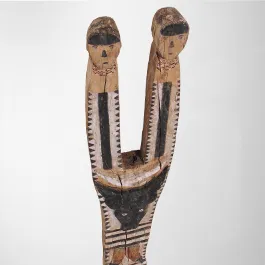Naga Monolithic Totem
Nagaland / XVIII - XIX Century

Naga Konyak
Coming from the Naga Konyak tribe, this monolithic piece is a marvelous example of their cultural views. The typical wood-carved ethnic art motifs of the Naga people of north-eastern India were abstractions of mostly animal forms, with a defined relationship to important aspects of the ancient Naga animistic tradition.
A conglomeration of tribes native to the Northeastern part of India and Northwestern part of Myanmar, the Nagas speak over 89 different languages and dialects and share a similar culture and customs.
Recognized as expert craftsmen, they hold a strong warrior tradition, as this pieces demonstrates, Naga totems are traditionally carved with their warrior hunting spears.
Totems have been associated with divine and magic powers attributed to a sacred animal that serves as protector of the tribe. Each motif had a symbolic aspect. Human figures or sculpted heads related to fertility or the head-hunting warrior tradition were inscribed on wall panels or as individual ritual art pieces. Bison heads, tigers, elephants, snakes, hornbills, barbets, lizards and monkeys were the common animal motifs all of which were symbolic of variously favoured human traits like valour, fertility and power or strength which were the core values of the traditional social system.
Within the large pantheon of symbols, the hornbill and the Indian bison or mithun were the most common motifs among the diverse Naga tribes and had great relevance and symbolism in the Naga tradition. The representation of these animal, human and other forms in wood carving was largely found in architectural fenestration or as façade elements.
Naga motifs
The animal and celestial motifs found in Naga architecture were styled with an intrinsically stark bold beauty. Decorative elements like the carved front wall panels were found only in the chief’s house or adorning the house façades of men of social distinction.
These planks were carved in relief with mithun heads, tigers, meat chunks and women’s breasts, signifying social status, power, protection, wealth and prosperity.
The mithun (gayal) or the Indian bison (bos fontalis) is synonymous with Naga culture. Being semi-domesticated, and having a designated owner even though it lives in fenced-off tracts in the wild, the human-animal relationship is unique. It is the state animal of both Nagaland and Arunachal Pradesh.
The mithun head or horns are almost a signature of Naga architecture inasmuch as they overshadow all other motifs in their magnificence and variety especially in the vernacular wooden architecture of the many tribes of Nagaland. The number of horns in this totem symbolize the relative prosperity and fertility of the tribe as well as their strength to resist other clan’s attacks.



Wealth, prosperity and fertility
The mithun is a powerful symbol of wealth, prosperity and fertility and dignifies house façades in the form of mithun head carvings which traditionally declared the social status of the owner.
Among the Nagas, these large panels, hewn from enormous logs of wood, were placed on village gates, ceremonial posts, house fronts and morungs, that is a particular community hall, as they were intended to be seen immediately on entry.
Carved symbols that proclaimed social status and wealth, courage and skill at warfare and were intended to inspire respect among peers and fear in enemies.

